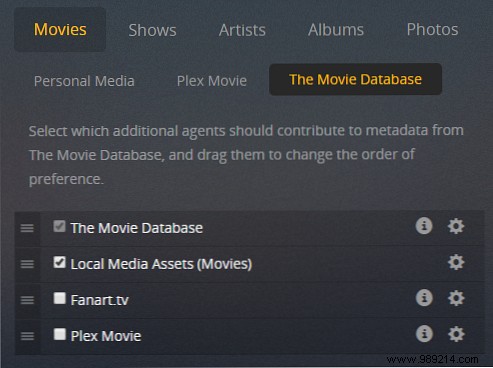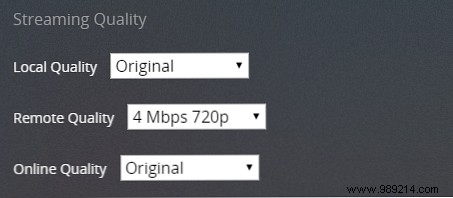If you have an extensive collection of locally saved media, chances are you've heard of Plex. Along with Kodi, it is one of the best applications to manage, view, launch and explore all your content.
The app can support video, music, and images, and works with a wide variety of formats within each category. It also lets you access your media remotely - you don't even need a Plex Pass 5 Reasons You Really Don't Need a Plex Pass 5 Reasons You Really Don't Need a Plex Pass If you have a lot of files stored locally on your computer, Plex it is a must-have software. But do you really need to pay for a Plex Pass? Let's find out... Read More
However, unlike Kodi, Plex is easy to set up and use. While customizing Kodi is a minefield of plugins, repos, and settings, Plex works out of the box.
But that doesn't mean there aren't some options you should tweak. We've already shown you some Plex Tips and Tricks 8 Plex Tips and Tricks You Really Need to Know 8 Plex Tips and Tricks You Really Need to Know Plex is awesome software. Simply put, it allows you to stream your media anywhere in the world, on any device, whenever you want. But there's a lot more to it than that... Read More
Plex can automatically extract metadata for your content. Although you need to format the filenames of your content The Optimal Way to Name Media Files in Plex The Optimal Way to Name Media Files in Plex Please read very precisely for it to work, it's worth doing.
Of course, Plex can add movie posters and TV episode names, but the metadata goes much deeper. You'll learn which actors were in a show, which TV channel the show aired on, who directed each movie, and what different critics on big-name review sites thought about the content.

Once the metadata is added, you can use it to search for related shows, other movies that certain actors have starred in, etc.
But none of this will work if you don't configure your agents correctly. You need to make sure Local Media is set below other metadata sources. Otherwise, Plex will use the file's existing local metadata as its primary source. In many cases, this metadata will be incorrect.

To change the order, go to Settings> Server> Agents . Using the tabs at the top of the screen, go to Movies> The Movie Database . Drag Local Media (Movies) below The movie database . Then go to Shows> TheTVDB and move Local media (TV) below TheTVDB .
One of the best features of Plex is its ability to stream content outside of your network. It has two main uses:Allows you to watch your videos when you're away from home View your Plex media from anywhere View your Plex media from anywhere One of the most overlooked features of Plex is remote access, which allows you to view all your Media from anywhere in the world. Read More
Setting up remote access itself is easy. Just go to Server> Remote Access and click Enable remote access .
However, you may also want to adjust the upload speed. This is especially true if you don't have a fast upload speed from your ISP, or if multiple people will be streaming content at the same time. Restrict speed will prevent the internet speed of your home network. Fix your Internet speed with these Windows tweaks. Fix your Internet speed with these Windows tweaks. Data Usage. Read More

Back to Server> Remote Access and scroll down until you reach Upload speed . You can set the maximum speed of your Internet by filling in the box next to Internet upload speed . Underneath, you can set how much of the maximum capacity Plex can use. Expand the dropdown menu to make your choice.
Note :By default, Plex is limited to 80 percent of its full speed.
Plex can transcode your videos so they can be played on other devices.
For example, desktop computers and laptops typically have powerful processors that can handle most file formats, codecs, resolutions, and subtitles. However, mobile devices and set-top streaming devices may have issues. Therefore, Plex can alter your videos on the fly to make them compatible with other gadgets.

The drawback of transcoding is that it requires a lot of CPU. If your Plex server is running on a non-dedicated computer, you probably don't want all of your CPU power being consumed. Even if you have a dedicated server, you will eventually reach your limits if many items are transcoded at the same time.
The solution is to adjust your transcoder settings (Settings>Server>Transcoder ). There are three values you need to know:
The Optimize function is best thought of as a “pre-transcoder.” It allows you to select certain videos and convert them to another format.
For example, if you know what you want to see. Toy Story , Beauty and the Beast , and Ordinance on your iPad while traveling for work next week, you can optimize the video files in advance. It means that they will be instantly ready to play on your chosen device. No further transcoding will be necessary.
Media optimization is also useful if you know that many people will be watching a video remotely at the same time, as it will relieve pressure on your CPU.

You can optimize an individual show, a series, or even your entire library. To get started, navigate to the content you want to adjust, click the three horizontal dots, and choose Optimize .
In the new window, you can select whether you want to optimize a certain number of videos or just the unwatched videos. More importantly, you can set the quality of the optimization. You can choose between Optimize for mobile , Optimize for TV , Original quality , or Custom . Custom settings allow you to specify a specific device, resolution, and bitrate.
If you set up a long list of items to optimize, you can manage the queue by going to Conversion Status . You can manage your already optimized files in Settings> Server> Optimized versions .
Each Plex app has its own streaming quality settings. As such, you can choose different settings for your computers, mobile devices, streaming boxes, etc.
The settings you choose determine the quality and resolution of any video played on your device. The lower the setting, the lower the video quality. However, it will load faster and use less bandwidth. So it's worth taking the time to adjust these settings on each Plex client you use.

You have three settings to adjust:Local Quality, Remote Quality, and Online Quality.
Mobile users can also adjust remote network transmission and Wi-Fi transmission individually.
In this article, we'll walk you through five of the most important settings to adjust if you want a seamless Plex experience, as well as provide some case studies for when it's appropriate to change each setting.
If you're a Plex expert, we want to hear from you. What other settings do you think new users need to know about? You can leave all your suggestions in the comments below. Or share this article with your friends who use Plex.